I really go on a ramble here about this movie, though it is more a ramble about John Wayne’s acting and speech pattern than the film. This is considered one of the great westerns by many and I would be among them. However, while I like Wayne in it and think it’s one of his best roles, it is not my favourite John Wayne performance.
20 Movies: Once Upon a Time in the West (1968)
Look out. I’m back to westerns. I love them.
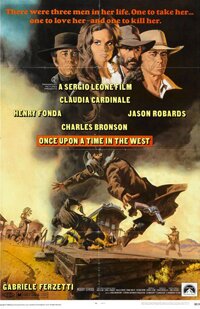 Once Upon a Time in the West (1968)
Once Upon a Time in the West (1968)
directed by Sergio Leone
From it’s incredible opening to the closing credits, Once Upon a Time in the West is a mesmerizing movie about westerns. In a way, it isn’t even about westerns. It simply evokes them with a stream of iconic images.
The movie takes a simple, almost cookie cutter story, and uses it as a basis (and excuse) for a film that is essentially concerned with western myths and iconography. (Sergio Leone had done this before, as in The Good, the Bad and the Ugly.)
It’s a post-modern film; it takes a kind of deconstructionist approach to movie-making (which may seem a tiresome idea today but was unusual in 1969).
At the centre of the film’s narrative is Claudia Cardinale as Jill. Around her three other characters revolve: Henry Fonda as Frank, Jason Robards as Cheyenne and Charles Bronson as the man with no name (often referred to as Harmonica).
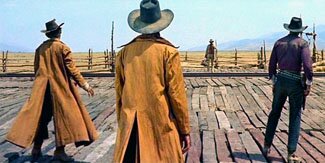 The owner of a railroad company, Morton (Gabriele Ferzetti), hires a psychotic gunfighter, Frank (Henry Fonda) to get rid of anyone in the way of the completion of his railroad.
The owner of a railroad company, Morton (Gabriele Ferzetti), hires a psychotic gunfighter, Frank (Henry Fonda) to get rid of anyone in the way of the completion of his railroad.
Frank does, by massacring the family of new bride, ex-whore, Jill.
With her new family dead, Jill must decide what to do with the land she has inherited. It seems worthless but proves to be very valuable, so valuable it is the reason her family has been killed. It’s a basic western formula: bad guys after the good guy’s land. He must defend it and himself, except in this case “he” is “she.”
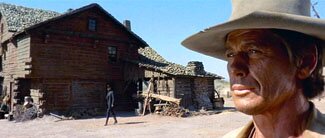 At the same time, bad-guy Frank starts being stalked by a mysterious stranger (Charles Bronson). Frank doesn’t recognize him, he has no idea what the stranger wants. As for Jason Robards’ Cheyenne, he gets involved in all of this because Frank has framed him for the killing of Jill’s family.
At the same time, bad-guy Frank starts being stalked by a mysterious stranger (Charles Bronson). Frank doesn’t recognize him, he has no idea what the stranger wants. As for Jason Robards’ Cheyenne, he gets involved in all of this because Frank has framed him for the killing of Jill’s family.
For a film almost three hours long, it doesn’t seem much to work with. But Leone is interested in the storyline only to the extent that it provides him something to improvise on western themes and imagery. He plays with these and it is what he does with them that makes this such a great movie.
I can’t imagine how this would look in pan-and-scan form. Leone makes incredible use of the screen’s width, visually stretching it out with foregrounds oriented to one side and breathtaking backgrounds to the other.
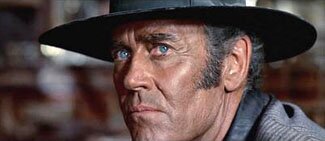 He also contrasts the breadth and spaciousness of his wide shots with the most extreme of close-ups. He shoots human faces almost as if they, too, were landscapes. The opening sequence is a spectacular example of this as he lingers on the bored killers’ faces. He shows us every detail from lines to whiskers. You almost get the sense he uses only two shots – very close or very long.
He also contrasts the breadth and spaciousness of his wide shots with the most extreme of close-ups. He shoots human faces almost as if they, too, were landscapes. The opening sequence is a spectacular example of this as he lingers on the bored killers’ faces. He shows us every detail from lines to whiskers. You almost get the sense he uses only two shots – very close or very long.
He also uses his trademark technique of drawing scenes out to their absolute limit. The opening goes something like eight minutes before anyone says anything and it is a scene simply about three guys waiting at a train station. You get an almost visceral sense of their tedium.
With scenes like gunfights, they are choregraphed to evoke iconic imagery and are paced, again, incredibly slowly to draw them out to their limits. When violence does erupt, it is explosive and very brief. Leone has little interest in violence itself but is obsessed with its rituals.
 Whether the movie is about anything is debateable. Leone seems interested primarily in style and evoking the western. (Once Upon a Time in the West is littered with references to earlier Hollywood westerns like High Noon, The Searchers and numerous John Ford films. It’s even partly shot in Monument Valley where Ford shot so many of his westerns.)
Whether the movie is about anything is debateable. Leone seems interested primarily in style and evoking the western. (Once Upon a Time in the West is littered with references to earlier Hollywood westerns like High Noon, The Searchers and numerous John Ford films. It’s even partly shot in Monument Valley where Ford shot so many of his westerns.)
If there is a comment in the film, perhaps it is a critique of myths of America. In the film, everyone is dissatisfied. Everyone wants something more, from the railroad baron and his hired killer Frank, to the woman Jill and Jason Robards. In the land of the free, no one seems to be content with their lot (except, perhaps, for the murdered McBain.)
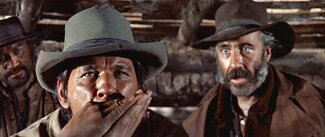 There may be something to the use of the railroad, too. Its arrival signals the end of the mythological West and the beginning of the modern age in the last American frontier. The train represents encroaching European civilization and the end of the mythical West, just as the film Once Upon a Time in America is a eulogistic end of the western.
There may be something to the use of the railroad, too. Its arrival signals the end of the mythological West and the beginning of the modern age in the last American frontier. The train represents encroaching European civilization and the end of the mythical West, just as the film Once Upon a Time in America is a eulogistic end of the western.
But in the end, the film is simply a great homage to westerns, as well as a kind of eulogy to them. It’s a stream of riveting images; an almost symphonic evocation of filmmaking style.


